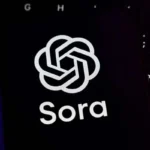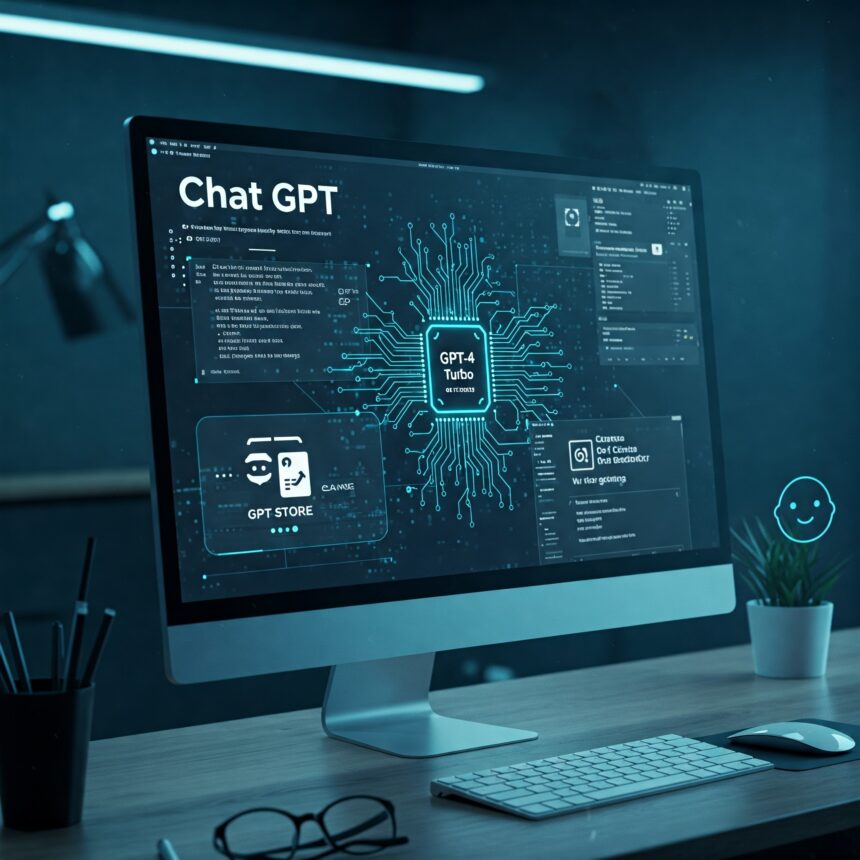In 20 minutes, find out how to customize your own GPTs on ChatGPT, publish them on the GPT Store, and have your very own customizable versions. But before that, let’s take an quick introduction to build the base we need.
Introduction
Artificial intelligence (AI) is evolving at an incredibly fast pace, with technological advances that blur the lines between science fiction and reality. OpenAI, the famous organisation behind the powerful GPT-3 language model, recently unveiled new customisable versions of ChatGPT, providing a boon for developers, content creators and businesses. In 2023, with the release of GPT-4 turbo, access to customised GPTs became a reality where users can generate virtual chatbots capable of performing specific tasks with stunning ease.
The purpose of this guide is to smoothly teach you the method of creating these customised GPTs, highlighting the new features offered by OpenAI, and how users, including non-developers, can now customise their own smart assistant. By exploring the subtleties of GPTs and the ease with which we can now model AI according to unique needs, we will detail the crucial steps so that you, too, can exploit these technological advances for your projects or job offers. Be careful, because we will also certainly address the inescapable issue of confidentiality and ways to secure your personalised assistants in this fascinating digital world.
I. Understanding TMGs and their usefulness in 2023 and 2024
The concept of GPTs, or pre-trained generative models, was born out of OpenAI labs and revolutionized the way we interact with artificial intelligence. At the heart of this revolution is ChatGPT, an impressive chatbot that uses natural language processing to interact, analyse data, and even write texts on demand. OpenAI has announced that the current iteration, GPT-4 turbo, has superior efficiency and precision to its predecessors, transforming human-machine communication.
These language models can be configured to assist in specific tasks, ranging from answering to simple questions to complex content generation, or even helping to code through the OpenAI API. The customization potential, announced at OpenAI’s first Dev Day conference, is one of the most exciting new features. This means that users can now create custom versions of ChatGPT, designed specifically to address the particularities of their applications or business needs.
II. Access and prerequisites for creating a personalised GPT
Before diving into the creation of your personalised GPT, some prerequisites are necessary. To start with, a ChatGPT Plus account is essential, an OpenAI premium service that provides users with access to advanced functionalities and higher computing power. This service also offers creators the opportunity to monetize their creations through the GPT Store. To subscribe, nothing could be simpler: go to your OpenAI account and follow the guidelines to “My plan” to activate your subscription.
Access to APIs, introduced by OpenAI, also plays a crucial role. These interfaces allow creators to connect their customized GPTs with different platforms and applications, offering unparalleled versatility and interconnectivity. For those who venture into this field, basic coding knowledge is advised to take full advantage of these powerful tools.
OpenAI plans, together with custom GPTs, to develop assistants who respect individual preferences, while offering additional integrated knowledge. The user must also have an understanding of prompt engineering – the art of dialoging with AI – to refine its interactions with the system and obtain more relevant responses.
III. Simple creation of your customized GPT with GPT Builder
The creation of a customized GPT is now within everyone’s reach thanks to GPT Builder, an innovative tool that OpenAI unveiled to simplify chatbot development. This intuitive platform allows everyone, without the need for in-depth AI skills, to shape their own GPT. OpenAI assures that users, as of Monday 6 November 2023, will be able to benefit from this simplicity of use, by strengthening the proximity of artificial intelligence to the general public.
Using the GPT Builder is a breeze; log into your OpenAI account, access your dashboard and select the option to create a new GPT. Enter key information on the desired use of your virtual assistant. Answering specific questions, e-mailing customer tracking, or engaging visitors to your site using a virtual cookie are tasks that your creation can perform with disconcerting ease.
OpenAI also focused on ease of integrating external data, allowing your GPT to feed on shared information in a simple form. Creators will therefore be able to easily add data to their chatbot to drag it into their image. Thanks to the 128,000 entry tokens offered with the use of GPT-4 turbo, now three times cheaper than GPT-3.5 turbo, it is now economically viable to customise its AI experience.
IV. Intermediate configuration to improve your GPT
Personalization does not stop at creating your own GPT; it extends to the refinement of your GPT through intermediate configurations. After defining the basics of your GPT, improving its accuracy and relevance depends on more nuanced settings. OpenAI has optimized this step by providing configuration options that modulate the behavior of your AI assistant according to your requirements.
Setting up more advanced instructions
The advanced instructions are the core of prompt engineering – the ability to guide your AI to get specific and useful answers. Mastery of the language you use to interact with your GPT is crucial. By fine-tuning the way you formulate these instructions, you direct AI to answer complex questions, manages follow-up tasks or performs actions taking into account variables specific to your domain.
Customisation of predefined questions
Each GPT comes with a set of predefined questions, serving as a starting point for interacting with AI. These primers can be customized to align with the needs of your company or community of users. By rewording these issues, you create a ground for dialogue that resonates better with your target audience while making full use of the capabilities of your TMG.
The importance of the language of response and visual presentations
The language used by your GPT should be consistent with that of your audience. TMGs are designed to communicate in several languages, but it is essential to specify the expected response language. Moreover, the responses should not be textual only. The integration of visual presentation with Dall-E 2 allows your GPT to provide a richer experience by illustrating its words with relevant visuals.
The intermediate configuration is a step towards advanced customization of your GPT. This is where your virtual assistant really starts to reflect the identity and needs of your company or community. With attention to detail and a fine understanding of the capabilities of your AI assistant, you can turn your GPT into an incredibly powerful and adaptive tool.
V. Enrichment of the knowledge of your GPT
For your personalised GPT to be truly effective, it is not enough to create it; it must be enriched with knowledge. This crucial step allows it to be up to date with the most up-to-date information specific to your sector of activity or area of interest.
Sharing documents and information with your TPM
Your GPT can be formed from a personalised body of information, which enhances its understanding and optimises its responses. This means that you can provide them with any useful documents, whether it is internal PDFs, press kits, or in-depth analysis reports. Thanks to this personalisation, your GPT has a unique pool of knowledge that broadens its expertise.
How to use the ‘knowledge’ section to download PDF files
OpenAI has integrated a particularly intuitive ‘knowledge’ section to download your documents directly to the platform. You select the PDF files containing the data you want, download them, and quickly, your GPT is imbued with it. This feature is essential to maintain a database up to date and relevant, allowing your GPT to respond accurately and accurately.
The impact of training on up-to-date data on the performance of your TPG
Training your GPT on up-to-date data has a considerable impact on its performance. A well-informed TMG will be able to answer sharp questions effectively, propose relevant analyses and even generate proactive recommendations based on the latest industry trends. This constant upgrade ensures that your GPT remains a competitive tool and a valuable resource.
Conclusion of the Party Enrichment your TPM with relevant data is perhaps one of the most important investments you can make in the implementation of AI. By ensuring that your GPT is continuously powered by up-to-date information, you maximize its potential and ensure an unrivalled quality service to end-users.
VI. Advanced creation and functional integration
Once you have enriched your GPT with targeted data, it’s time to move on to the next phase: deploy advanced features that will really put your virtual assistant apart.
Addition of options such as web browsing, visual creation and document processing
OpenAI now allows you to boost your GPT with web browsing capabilities, thereby increasing its information retrieval functionality. This option opens up a new field of possibilities, ranging from real-time data collection to news tracking. For creative people, the integration of Dall-E offers visual creation to custom – turn textual descriptions into images or ideas into concrete illustrations. As for document processing, whether for automated input, synthesis or classification, your GPT becomes an outstanding administrative assistant.
Configuration of advanced actions and API connection
The next step in customization is the interfacing of your GPT with external APIs. These connections allow your GPT to interact with other software and services, performing tasks such as website content updates, managing customer support tickets, or even triggering actions in IoT environments. This requires not only precision in parameterization, but also continuous monitoring to ensure secure and efficient integration.
Best practices in prompt engineering to maximise the efficiency of your virtual assistant
Prompt engineering is an essential skill in the creation of GPT. It’s the art of asking the right questions and formulating the right commandments to get the right result from your AI. A good prompt takes into account clarity, conciseness, and intent, bringing your GPT to perform at its best. By fine-tuning the prompts, you optimise your AI for fluid and natural cooperation.
The advanced creation of your GPT and the integration of advanced functionalities is what will make your assistant a remarkable tool. By mastering these steps, you will place your personalised GPT at the heart of your digital strategy, automating processes, enriching the user experience, and paving the way for countless opportunities for engagement and interaction.
VII. Publication and use of your GPT on the OpenAI GPT store
Once customized and enhanced with advanced features, your GPT is ready to be shared with the world. Whether you want to keep it for a small circle or make it available to the general public, OpenAI offers a platform adapted to host and present your creation.
How to register your GPT for personal, shared or public use
Your GPT can be saved on the OpenAI store in three different ways. For personal use, you keep it private, accessible only via your account. If you opt for restricted sharing, a single link is provided, which you can distribute to your collaborators or to a targeted audience. Finally, for wider availability, posting your GPT on the GPT Store allows any user to run your Virtual Assistants.
The importance of naming and logo in the GPT awning
The image of your GPT in the blind is decisive for its adoption. A distinctive name gives it personality and facilitates its memorization. The logo, on the other hand, must not only capture attention but also reflect the function or spirit of your GPT. A strong visual identity increases the likelihood that your creation will stand out in an increasingly saturated market.
Tip to publish your own GPT on the store and potentially generate income
Publishing your TPM is a fairly simple but thoughtful approach. OpenAI offers tools to submit your GPT to the store with guided steps to ensure that all legal and descriptive aspects are covered. As for monetization, once your GPT is popular and used on a large scale, there are opportunities to generate income, whether it comes from partnerships or a subscription model that you could offer for more advanced or personalized services.
Publishing your customized GPT is the last step in the creation process. It’s crucial, because that’s where your product takes off and becomes accessible to the world. Whether you keep your GPT for internal use or choose to benefit from it the wider OpenAI community, make sure that your publication is designed to reflect your ambitions and values.
VIII. Security and management of GPTs on the blind
With the ease and accessibility of the publication of TGPs, security and management issues naturally emerge. The OpenAI platform is not only a forum for innovation, but also a space where trust and responsibility are of the utmost importance.
Vigilance in the choice of GPTs of the blind: safety and reliability
The GPT Store is populated by various creations, each with its level of sophistication and security. As a user, it is imperative to exercise due diligence when choosing a GPT. Read the descriptions, the opinions, and if possible, test the reliability before fully integrating it into your ecosystem. OpenAI strives to put in place rigorous security protocols, but the open nature of the platform calls for constant vigilance.
Responsibility for the use of a third-party GPT assistant
The use of third-party TMGs imposes a shared responsibility. For creators, this means ensuring that their TPGs comply not only with OpenAI guidelines, but also with existing data protection standards. For consumers, it means understanding how these TPGs interact with their systems and what data are processed. In case of doubt, OpenAI offers mechanisms to report problems or even to oppose the deletion of a specific GPT at any time.
Community contribution and feedback to improve available TGPs
Community feedback is one of the mainstays of the continuous improvement of GPTs on the blind. Users are encouraged to share their experiences, to report on their successes and problems encountered. Developers benefit directly from feedback that helps them refine their creations. OpenAI promotes this dynamic exchange between users and creators through comments, notes, and dedicated feedback channels.
The OpenAI GPT ecosystem is both flexible and innovative, but with this greatness comes a great responsibility. It is crucial that all stakeholders – OpenAI, creators, and users – work together in a transparent and secure way to make the most of artificial intelligence, while maintaining a reliable and ethical environment for all.
Conclusion: Use GPTs that benefit from the power of GPT-4 turbo.
After this journey to the heart of creating customized GPTs, we can confirm that the horizons of artificial intelligence are expanding day by day. Thanks to the innovative platform set up by OpenAI, in particular since April 2023, the possibility of creating tailor-made intelligent assistants has become a tangible reality for a growing number of people, from professionals to enlightened amateurs.
GPTs can now be shaped to become tools for a wide range of visions. Whether it’s meeting business needs through OpenAI’s Enterprise versions, conducting content strategies through advanced chatbots, or fighting threats like ransomware with prepared AI – the potential is limitless.
With the significant cost reduction, symbolised by the GPT-4 turbo model, which offers input tokens three times less expensive and output tokens that are half as expensive as those of its predecessors, the development of these generative artificial intelligence technologies has become less financially heavy. The OpenAI marketplace, enriched with user contributions through their already available data, is a fertile ground for sharing innovations and collaborative rectification.
As a creator, this universe provides you with a myriad of tools: from adding web browsing options to the API connection, the possibilities are available to you. Sam Altman, an open leader, assures us that this is just the beginning of an era where AI assistants can actually work with humans.
As we close this guide, let’s recognize the transition from simple job openings for developers to a catalyst for the knowledge and creativity economy.
——
Customized GPT FAQs with ChatGPT
What is GPT-4 turbo?
GPT-4 turbo is the latest version of the pre-trained generative language model developed by OpenAI, offering improved performance in terms of efficiency and accuracy compared to previous versions.
How can I create a personalised GPT?
To create a custom GPT, you need a ChatGPT Plus account, access GPT Builder via the OpenAI dashboard, and follow the instructions to configure and train your GPT according to your specific needs.
What is the GPT Store?
The GPT Store is a platform developed by OpenAI that allows users to publish, share, and possibly monetize their custom GPTs with a wider audience.
Do I need programming knowledge to create a personalised GPT?
Although a basic coding understanding is useful, tools like GPT Builder were designed to allow non-developers to easily create their own customized GPT.
What is prompt engineering?
Prompt engineering is about effectively writing requests to AI to direct GPT responses to specific and user-relevant results.
Can I customize GPTs without subscribing to ChatGPT Plus?
Advanced customisation of GPTs is currently a feature reserved for ChatGPT Plus subscribers, which offers additional customisation options and increased computing power.
How do I integrate external data into my GPT?
OpenAI simplified the integration of external data through forms and the option to download files in the ‘knowledge’ section of GPT Builder.
Can my GPT be multilingual?
Yes, personalised TGPs have been designed to communicate in several languages. You must specify the desired response language when configuring your GPT.
Can I add web browsing capacity to my GPT?
Yes, with the latest OpenAI updates, you can equip your GPT with web browsing capabilities, thereby increasing its information retrieval functionality.
How do I secure my custom GPT?
It is crucial to apply security protocols recommended by OpenAI, monitor access to your GPT and ensure that its use complies with data protection standards.
Is it possible to monetize my customized GPT?
Yes, by publishing your GPT on the OpenAI GPT Store, you can potentially generate revenue through partnerships or by offering a subscription model for more advanced services.
How can I post my GPT on the GPT Store?
To publish your GPT, log into the GPT Store, follow the guided steps to submit your creation, and make sure that all legal and descriptive aspects are covered.
What information can contain a personalised GPT?
A personalised GPT may contain information specific to your sector or area of interest, such as internal documents, analysis reports and relevant external data.
How do I use the OpenAI API with my custom GPT?
To connect your custom GPT to different platforms or applications, use OpenA APIs. Knowledge of programming may be needed for this integration.
What is GPT Builder?
GPT Builder is a tool provided by OpenAI designed to simplify the creation of custom GPTs, accessible via the OpenAI dashboard.
What are the “entry tokens” and “tokens” in GPT-4 turbo?
The input and output tokens correspond to the text units processed by GPT-4 turbo during the generation or reception of an input by the model. The cost reduction of token costs makes the use of turbo GPT-4 more economically viable.
How can I improve the accuracy and relevance of my customized GPT?
To improve the accuracy of your GPT, refine the configuration parameters and the formulation of the instructions by optimizing the interaction using prompt engineering.
Can I integrate visuals generated with Dall-E into my GPT?
Yes, it is possible to combine the capabilities of GPT-4 turbo with Dall-E to generate relevant visuals that match or complement text responses in your GPT.
How do I track the upgrades of my custom GPT?
To stay up to date, follow OpenAI announcements, engage in community forums, and listen to returns to incorporate upgrades and improvements.
What are the implications of using a third-party TPG?
The use of a third-party TPM implies a shared responsibility for safety and compliance. It is essential to understand how these models process and interact with your data.
Are there any restrictions on the type of data I can load into my GPT?
OpenAI imposes restrictions to ensure that the loaded content complies with the privacy policies and laws in force. Avoid sensitive or private data without appropriate permission.





